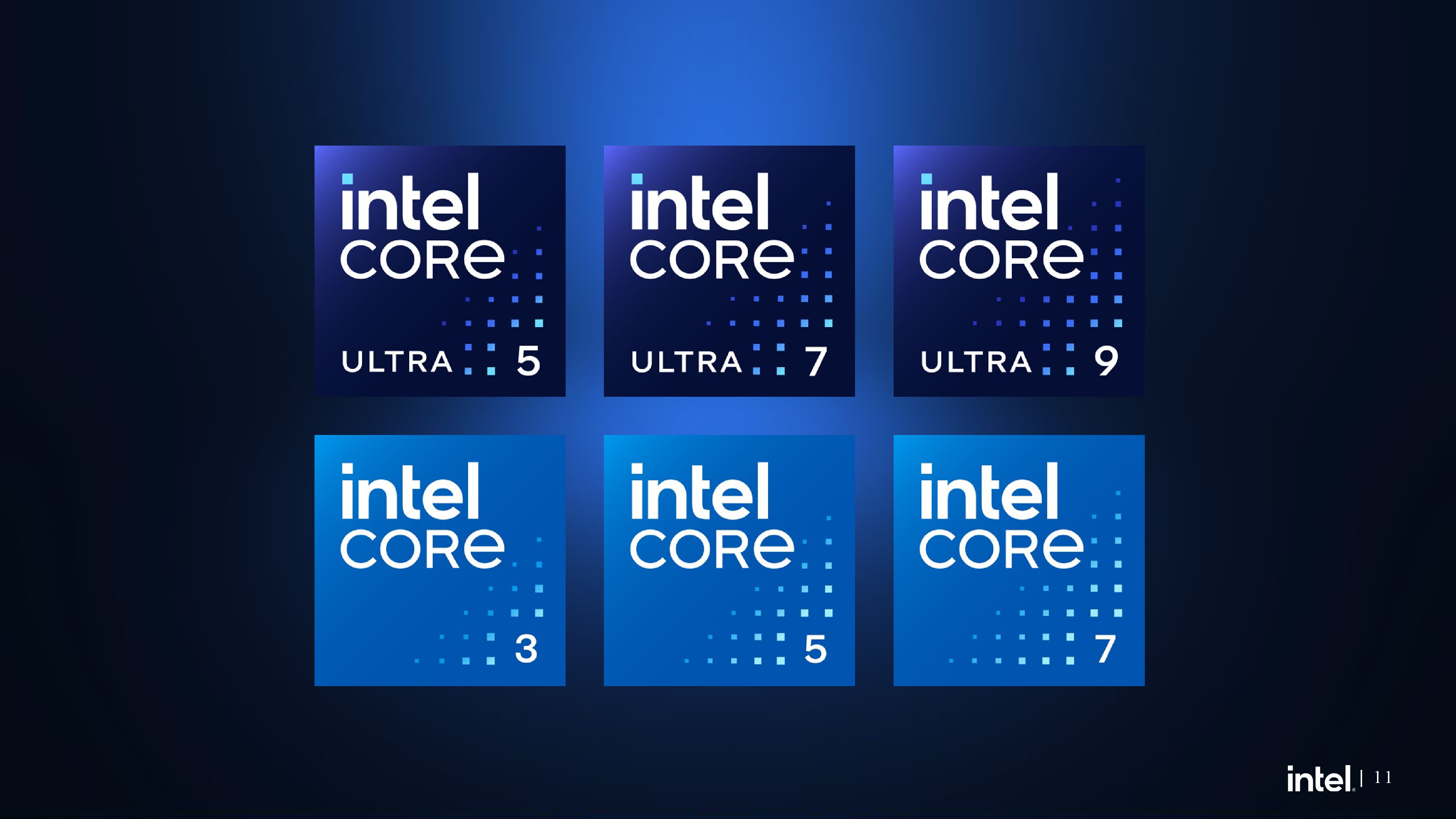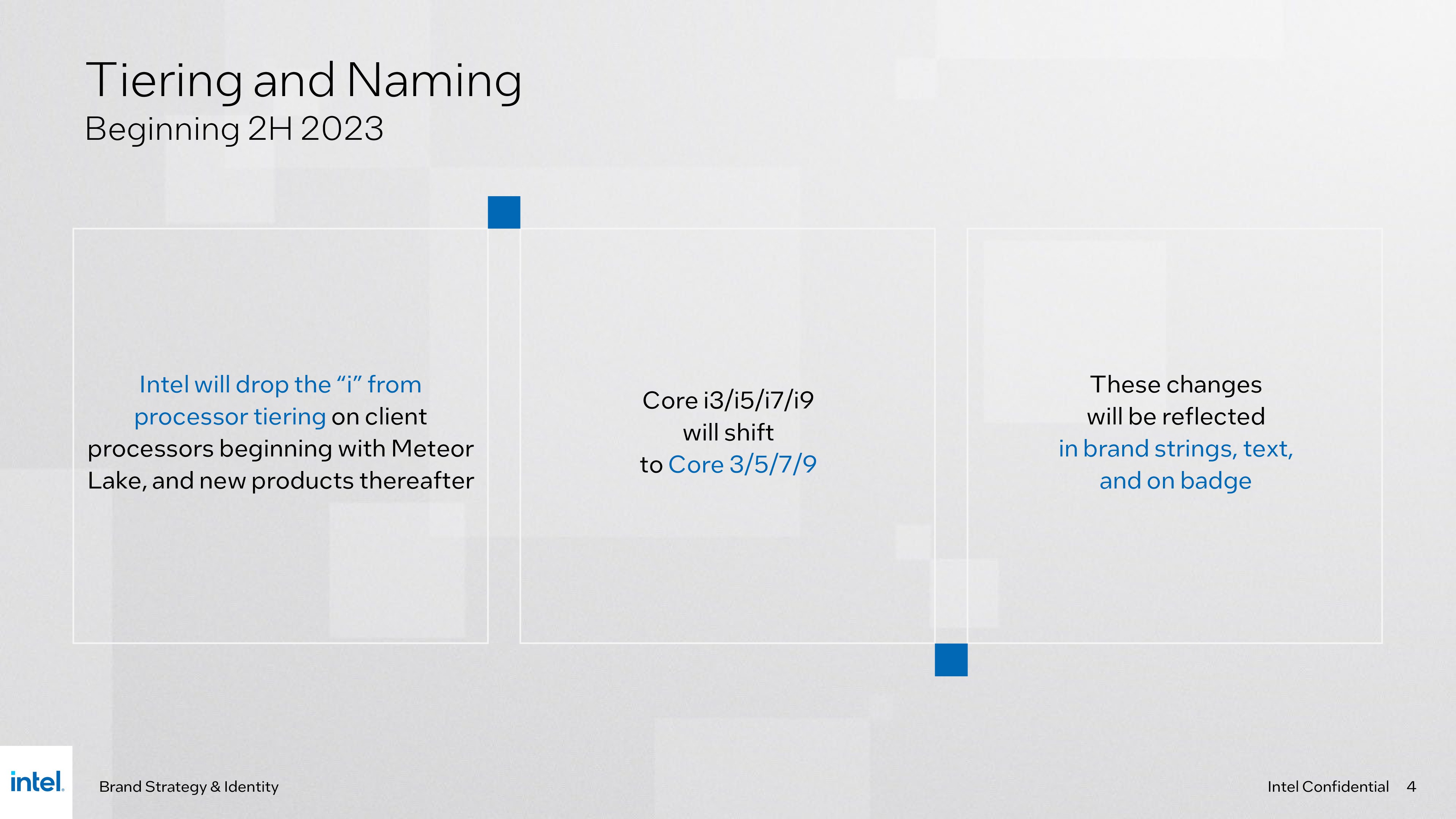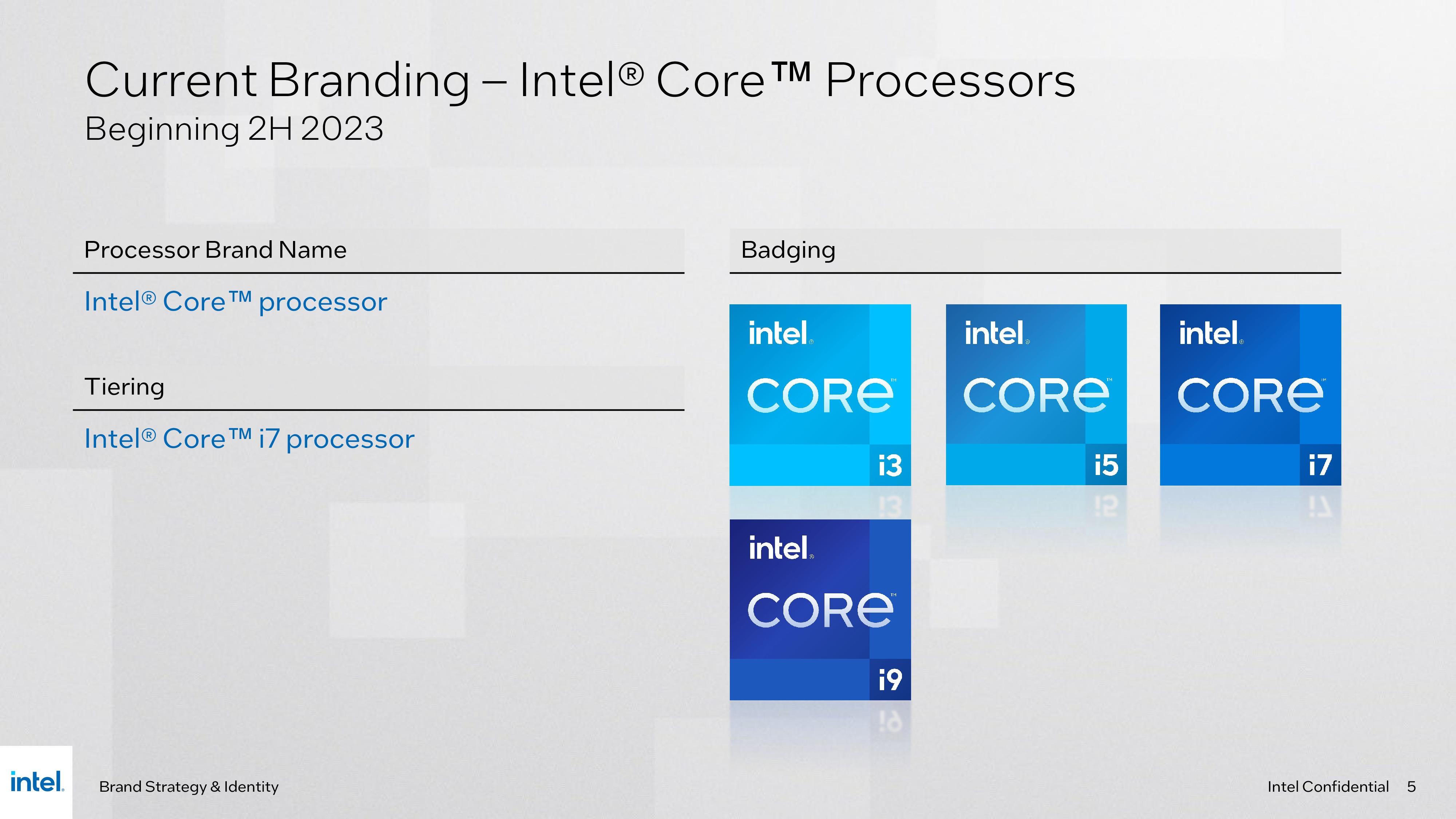Intel's New Core Ultra Branding Drops the i, Looks Like AMD's Ryzen Branding
Brand equity? What's that?

Intel announced today that it is overhauling its consumer CPU branding for the first time in 15 years, resulting in a simplified naming scheme that looks somewhat similar to AMD’s Ryzen naming scheme. Intel’s new approach focuses on its ‘Core’ branding and splits the chips into ‘Core’ and ‘Core Ultra’ tiers. It also drops the iconic ‘i’ from the i3, i5, i7, and i9 chip identifiers and no longer refers to its processors with a generation moniker, like ‘13th-Generation.’ It also includes new badges, all of which we’ll cover more below. These changes begin with the Meteor Lake processors that come to market later this year but don't apply retroactively to existing chips.
Intel’s announcement comes after the new chip naming scheme emerged a month ago when new ‘Ultra’ badged processors were listed in processor benchmarks on a public database. Intel’s latest rebranding follows other retoolings of its public image, such as changing the iconic Intel logo and jingle, with the latter receiving more than a fair bit of negative feedback. Intel has also recently discarded other Intel hallmarks, like the Pentium and Celeron brands that were once household names. That change also wasn’t well received.
Intel says the Meteor Lake chips are “an inflection point for design, manufacturing, and architecture and delivers significant advances for our company and customers,” and that the changes are the result of customer requests to simplify its brand.












Intel will now split its future chip generations into two tiers: 'Core’ mainstream models and ‘Core Ultra’ premium chips, with the latter indicating a higher tier of performance. Intel has also dropped the generation designator from its brand name, but you can still easily decode that from the product number. For example, the ‘13’ in 13900K indicates the chip is a 13th-Generation model, and that portion of the naming scheme will remain consistent with the coming generation. Intel also has new badges, which you can see in the above album.
Perhaps the biggest outward change is the decision to drop the ‘i’ from the Core i3, i5, i7, and i9 lines. Here's a mockup of how the old branding would have looked for the coming 14900K chips, and a few examples of how it will look under the new official scheme:
- OLD: Intel 14th-Generation Core i9-14900K Processor
- NEW: Intel Core Ultra 9 processor 14900K
- NEW: Intel Core 9 processor 14900K
- AMD: Ryzen 9 7950X
As you can see, Intel also includes the word 'processor' in the official product name. This is technically already present in the current branding scheme even though absolutely no one uses it in common usage -- even Intel doesn't. However, now Intel inexplicably injects the word between the family designator (Core 9, Core Ultra 9, for instance) and the model number, instead of at the end of the name.

We asked Intel's brand team about this, and they said they 'prefer' for the term 'processor' to be used, but that the real focus is on the 'Core' and 'Core Ultra' branding. Given that even Intel itself doesn't use the existing 'processor' designator already, we doubt that the new superfluous 'processor' portion of the branding will catch on. Here's another mockup, but this time of how the branding will look in common usage:
- OLD: Intel 14th-Generation Core i9-14900K
- NEW: Intel Core Ultra 9 14900K
- NEW: Intel Core 9 14900K
- AMD: AMD Ryzen 9 7950X
Make no mistake, this will probably be the most common usage you'll see in reviews and in general reporting. As you can see, without 'processor' injected in the brand string, Intel's new mainstream chip branding is very similar to AMD's Ryzen branding. Yes, the Core Ultra-branded parts will have the extra bit of 'Ultra' to differentiate, but the new scheme feels very Ryzen-esque without the 'i' in Core i9. More on that below.
Intel hasn’t confirmed yet, but we do know from a mountain of external evidence that its next generation of chips will have two swim lanes — processors based on Meteor Lake, a totally new 3D-stacked design with a new microarchitecture, and the Raptor Lake Refresh models, which use the same design and microarchitecture as the currently-shipping processors but have extra tuning to improve performance.
We spoke with Intel’s branding team and asked if the new Core Ultra branding will apply to the newer Meteor Lake models while the refresh models will fall under standard Core branding, and/or if the overclockable K-series processors would be confined to Ultra-branded products only.
Intel didn’t confirm that only Meteor Lake chips would only be marked as Core Ultra but did say that tier ‘represents the latest innovations’ and that they would share more details soon. That means it is at least a rational assumption. However, the representatives did say that overclockability (K-series) isn’t a requirement for a chip to be branded as Core Ultra.
Thoughts
It is certainly a bold yet questionable decision to remove the branding that hearkens back to when Intel had a near-monopoly on the market and was the unquestioned performance leader for over a decade. The perception that Intel is diluting the hard-fought brand recognition built during those years is obviously going to be present, regardless of the market studies that Intel tells us it used to inform the decision.
Intel’s branding change will certainly be confusing for those that have become accustomed to the naming scheme over the last 15 years, but Intel tells us this change is designed to improve brand recognition with mainstream audiences that aren't tech-savvy. In fact, Intel feels that the 'Core' branding is already, well, the core of its brand equity, so it thinks dropping the 'i' sharpens focus on the 'Core' brand.
Today, Intel and AMD are more closely matched than we’ve seen over the last decade. AMD’s Ryzen processors did temporarily catapult the company back into an unquestioned leadership position, but Intel’s 13th-Generation Raptor Lake restored Intel’s overall lead with the best blend of performance and value for the bulk of the desktop PC market. Yes, AMD's Ryzen 7000 still holds the overall gaming lead with its premium lineup of X3D parts, but they carry a premium that relegates them to the highest-end systems, so they aren’t for most users.
That makes the timing of Intel’s rebranding even more confusing. It certainly isn’t uncommon for an underdog to adopt a similar branding scheme as the incumbent, often to leverage the better-known product branding from the dominant player to further their own brand — that’s exactly what AMD did when it launched its Zen-powered processors with a very familiar Intel-like Ryzen 3, 5, 7, and 9 scheme. In fact, AMD even adopted a very similar motherboard chipset branding to Intel, too.
Intel is certainly back on the upswing in the desktop PC market, but the optics of discarding the familiar 'i' portion will be sure to generate plenty of criticism. Though it probably wasn't intentional, some will also insist this looks like AMD's branding scheme for Ryzen. But, as mentioned, AMD first adopted an Intel-like branding scheme, making it hard for Intel to simplify its branding without ending up with a similar-looking approach.
Intel says it isn't sharing all of the details of the new branding scheme yet, and its slides indicate that it is still in the decision-making process on some of the details. That seems a bit dubious, given the proximity of the Meteor Lake launch later this year — surely these decisions have already been made. In either case, we'll learn more about the branding scheme when Meteor Lake arrives later this year.
Get Tom's Hardware's best news and in-depth reviews, straight to your inbox.

Paul Alcorn is the Editor-in-Chief for Tom's Hardware US. He also writes news and reviews on CPUs, storage, and enterprise hardware.
-
I think Intel is opting the ULTRA naming scheme to deal with the overlap of a significantly newer architecture with an older gen architecture already being in the market.Reply
So when Intel's Core Ultra branding takes effect, users will be able to tell "Meteor Lake/refresh" based SKUs apart from those based on "Raptor Lake," but looking for the Ultra brand. This might also help to transition the market between processor arch generations, and also to improve the inventory digestion, IMO. -
BTW, Intel has also announced new badge designs for Intel EVO, and the vPro brand that the company uses for its commercial desktop and notebook processorsReply
-
tennis2 I'm not sure why this article is focused so much on "Intel copied AMD" when we (I?) still don't fully understand what the difference between Core and Core Ultra is. Surely that's the bigger issue here.Reply -
baboma Good to see the Celeron & Pentium names bite the dust. They were holdovers from a bygone era that make no sense in the numeric scheme.Reply
>The perception that Intel is diluting the hard-fought brand recognition built during those years is obviously going to be questioned
I don't see any adverse impact from the name change. It is simple and intuitive enough to glean at first glance. It's not like there's a plethora of players in the market that CPU branding would make a product standout from the rest. There are only two players in the x86 market, Intel and AMD.
>Intel didn’t confirm that only Meteor Lake chips would only be marked as Core Ultra but did say that tier ‘represents the latest innovations’
It would be problematic if only MTL CPUs get the 'Ultra' designation, as MTL will only be the "latest innovation" for one year, and you can't retroactively change the parts' name when "latest" becomes "standard" and there's a new latest.
It would also cause confusion if unlocked 'K' parts forms its own distinct tier, as then there'll be 4 tiers to consider.
Per above, I think 'Ultra' will simply denote premium (ie K) parts. -
IamNotChatGpt Hey Intel this might be a wild guess but imagine if you'd drop the Core, Generation and Processor portion of the naming scheme, making it even more compactReply
CRAZY I know right! How could someone come up with that!
Intel Core Ultra 9 Ultra Processor 13th Generation 13700K
Intel 9 13700K -
tennis2 Reply
Especially if they're removing Pentium and Celeron, then one is to assume that they're all "core" now. But, remember that Xeon still exists (atom also?). That's probably why they're keeping Core.IamNotChatGpt said:Hey Intel this might be a wild guess but imagine if you'd drop the Core, Generation and Processor portion of the naming scheme, making it even more compact -
edzieba Reply
Yeah, seems pretty hilarious when you have AMD cribbing the entire lineup nomenclature, but when intel remove the letter "i" from their own branding they must be doing to to copy AMD! Especially with the whole song-and-dance Toms makes over why they ignore the 'processor' bit of the official branding (giving it a whole three paragraphs!) whist pretending anyone - including Intel themselves, such as on Ark - actually puts the 'XXth gen' bit of the branding in too.tennis2 said:I'm not sure why this article is focused so much on "Intel copied AMD" when we (I?) still don't fully understand what the difference between Core and Core Ultra is. Surely that's the bigger issue here.
In short:
Old: Core i7-13700K
New: Core 7 13700K
The 'Ultra' does not seem placed to be a core generation differentiator, but instead to differentiate a (for example) regular Core 7 from the top-of-the-range Core 7 with all GPU segments on the die enabled, or a higher TDP, or unlocked clocks, or all of the above. Think akin to the 'K' suffix familiar to the desktop line, but pushed into the up-front branding sticker. -
TerryLaze Reply
What can you throw farther, an apple or an orange?tennis2 said:What's faster, an Intel Core 7 or an Intel Core Ultra 5?
These will be different categories so this question will not be very relevant to most people.
If you need the ultra, for whatever reason, then it doesn't matter if the plain one is faster...
If you just need the faster one then it doesn't matter if it's ultra or not...